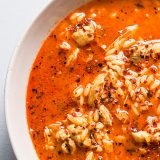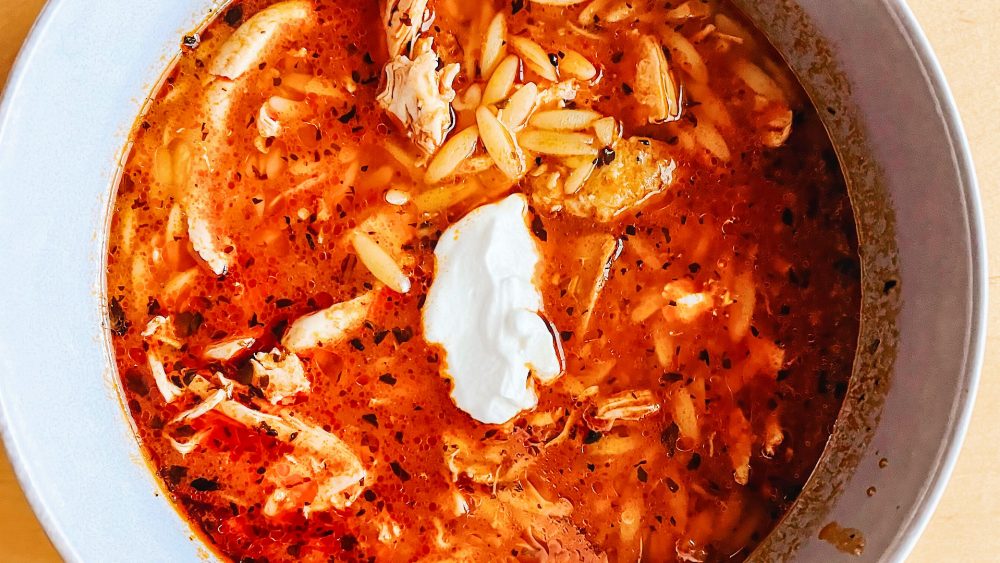Lunch is the hardest meal of the day. It’s a constant struggle between pre-made salads that cost a fortune and tiny crackers and chips that leave me hungry again an hour later. But with little time for prep and consumption, it can be difficult to find recipes that check every box. This Chicken and Orzo Soup with Garlic and Paprika offers the best of both worlds: high-impact ingredients that don’t require a lot of development, and a cook time that doesn’t leave me wolfing down my meal before I’m back on the clock.
For the uninitiated, allow me to introduce you to Cookish, the cookbook and ongoing Milk Street Magazine series that promises fewer ingredients (often six or less!), and minutes, not hours, spent in the kitchen. Cookish encourages you to shop your fridge and pantry first for the ingredients you need, and offers loose guidelines for throwing delicious, flavor-packed meals together fast—exactly what I want at lunchtime.
As promised, the ingredient list was simple: olive oil, garlic, paprika, tomato paste, chicken thighs, mint and orzo. After a quick trip to the pantry and freezer (the key to keeping costs low), I found everything I’d need. Sixty minutes were on the clock. Could I really make this soup in 40?
Prep work, if you can even call it that, was a breeze. The hardest steps—halving chicken thighs and processing garlic—took about five minutes in total thanks to a very sharp knife and the garlic press I can’t cook without.
Brown Your Tomato Paste and Bloom Your Herbs for an Instant Flavor Boost
The first step was browning the tomato paste. If there’s one thing we say at Milk Street constantly, it’s brown your tomato paste! Not only does browning deepen the paste’s already savory nature, it adds umami to the soup (and just about any dish). If you’ve ever tried tomato paste right out of the tube, you’ll notice the taste is highly acidic, almost metallic in nature. Cooking the paste first helps to mellow that metallic-y taste. How does it happen?The heat caramelizes the sugars in the paste and activates the umami-packed flavors in compounds called glutamates, which makes everything nice and savory. But be sure you stir often and keep an eye on it—there’s a very real difference between brown and burnt, and you’ll get there fast if you’re not paying attention.
The recipe calls for 1/3 cup of tomato paste, and as someone who doesn’t always vibe well with tomato-heavy dishes, I feared I’d be downing antacids the rest of the day. Not so with this soup. Browning the tomato paste before adding the other ingredients didn’t just add overall umami, it also helped to temper the paste’s acidity. The 7 cups of water the recipe calls for to cook the chicken also aided in the dilution process.
Once the tomato paste went from a bright cherry red to a rich, almost mahogany, I added the dried mint and paprika, letting them bloom in the oil and paste mixture to extract as much flavor as possible. You may be wondering why the recipe would call for dried instead of fresh herbs. While fresh is often best, using dried herbs provides a concentration of flavor that is difficult to achieve unless you’re doubling, possibly tripling the amount of the fresh stuff, plus there’s no knife work needed.
But if you look in your pantry and find only dried spearmint, not mint, take my advice: Either skip this soup, or make a quick grocery run; I once made the mistake of thinking the two were interchangeable, and let’s just say there was a very chewing gum-like quality to it. Not inedible, but definitely a noticeably different flavor profile.
Chicken Thighs Provide Flavor and Bulk
Instead of leaning on boxed broth as a base, chicken thighs are boiled in the tomato-y, umami-rich broth, giving it a meaty backbone and rich body. When the chicken thighs were cooked all the way through—about 20 minutes—I removed them from the pot and set them aside to be shredded. Then I turned my attention to the pasta.
We Won’t Need Thickeners Where We’re Going
With few ingredients and quite a bit of water, one might feel the need to add a thickening agent like a cornstarch slurry to add a little body. This soup didn’t need it! Cooking the orzo in the same pot that I boiled the chicken allowed the pasta to release its starches directly into the broth, naturally thickening and giving it an extra richness. Bonus: cooking the orzo this way meant one less pot to clean.
Putting It All Together
With the orzo cooked and the chicken thighs shredded, the final step was adding the chicken back to the pot to heat it up, and seasoning with salt and pepper. After adding a generous dollop of full-fat greek yogurt to the bowl, it was time to serve.
The result was a full-bodied soup, rich, but not heavy. The yogurt, which is optional in the recipe, added creaminess with the tiniest bit of tang. The chicken gave the soup the kind of heartiness that keeps you full for hours. The paprika, though subtle, added a little smoke and slight sweetness. And the mint gave it a complex herbaceousness without being overpowering, a concern I’d had when adding not one but two teaspoons of it to the broth.
I was finished with lunch with ten minutes to spare—plenty of time to clean and get the leftovers in the fridge. And with a recipe that yields enough for four servings, I’m guaranteed a fast, easy lunch all week. A word of warning, though: The orzo will soak up a large percentage of the broth while in the fridge, so add a little water when reheating to thin everything out.
Join the conversation on Facebook, Instagram, TikTok and Pinterest.
And if you're looking for more Milk Street, check out our livestream cooking classes with our favorite chefs, home cooks and friends for global recipes, cooking methods and more.





